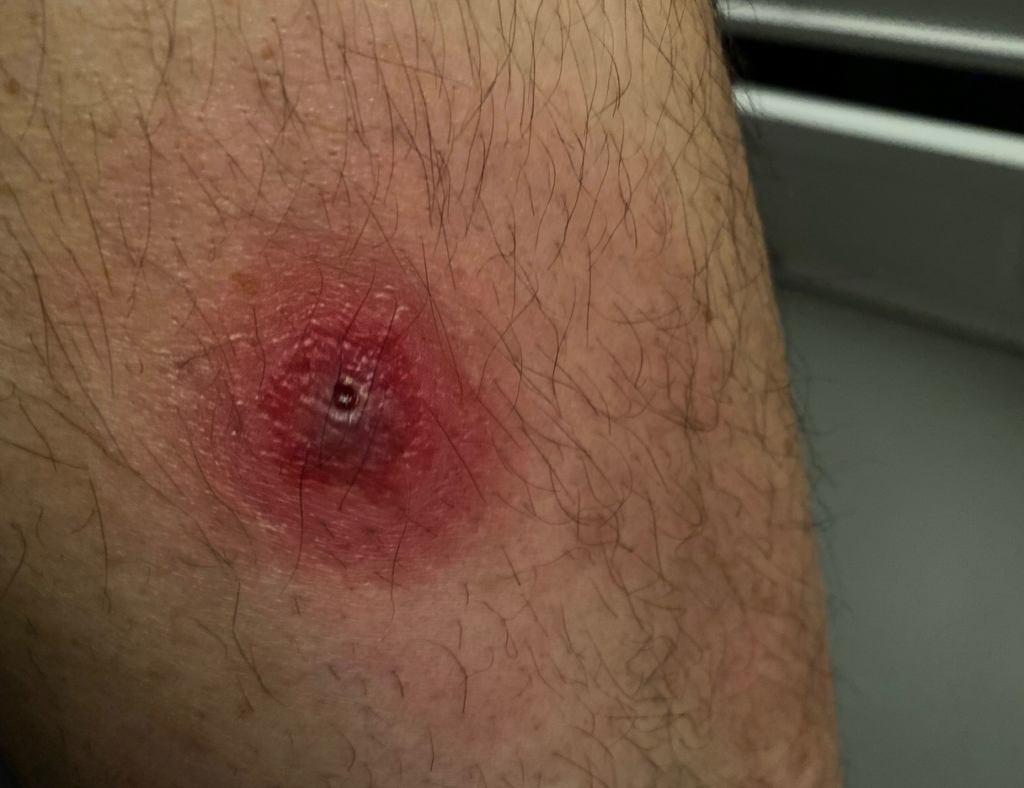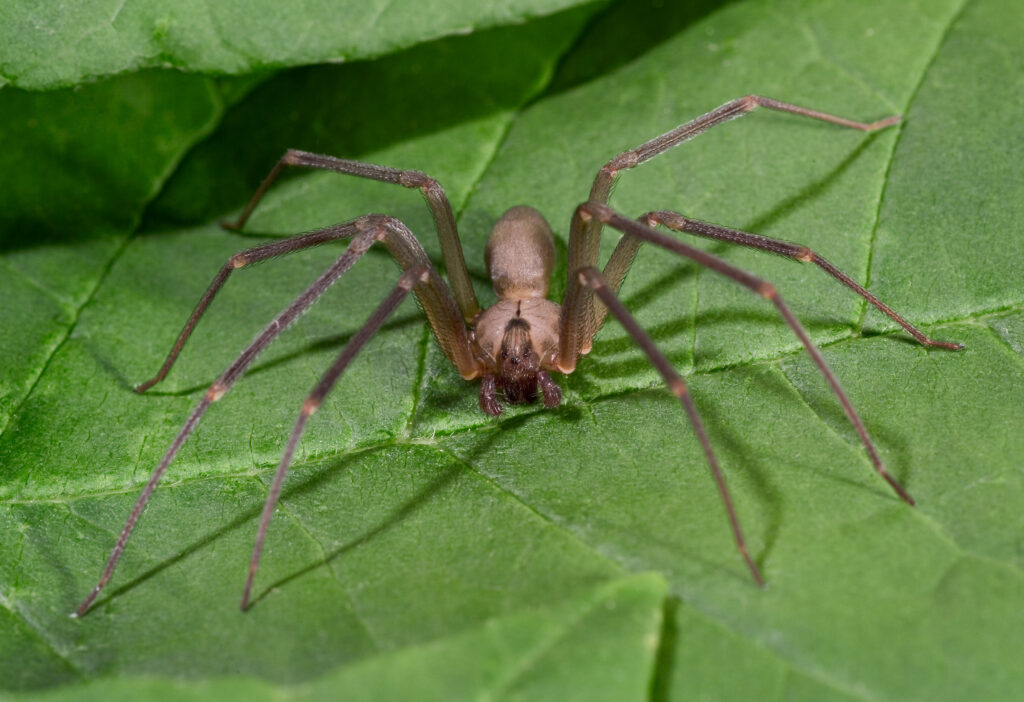Spiders are intriguing creatures, and among them, Brown Recluse Spiders (Loxosceles reclusa) have gained notoriety for their venomous bite and potential impact on human health. These brown spiders, native to North America, particularly the United States, are part of a group known as recluse spiders. In this in-depth article, we will explore the characteristics and behaviour of Brown Recluse Spiders, the symptoms and medical implications of their bites, as well as the various treatments available for their venomous bites.
Characteristics and Distribution
The Brown Recluse Spider is a medium-sized spider, typically measuring between 6 and 20 millimetres in length. It has a distinct violin-shaped marking on its cephalothorax, which is why it is often referred to as the “violin spider” or “fiddleback spider.” The colouration of Brown Recluse Spiders can vary from light brown to dark brown, and they possess three pairs of eyes arranged in a semicircular pattern. While the Brown Recluse Spider is primarily found in North America, particularly in the central and southern regions of the United States, there have been reports of their emergence in other parts of the world, including the United Kingdom.

Behaviour and Habitat
Brown Recluse Spiders are nocturnal creatures and tend to be reclusive in nature. They prefer to dwell in secluded areas such as abandoned buildings, sheds, and cellars. These spiders hide in dark corners, crevices, and undisturbed spaces during the day and become more active during the night when they hunt for prey. Despite their reputation, Brown Recluse Spiders are not aggressive and usually only bite when they feel threatened or accidentally come into contact with humans.
Venom and Medical Implications
The necrotic venom of Brown Recluse Spiders contains a mixture of enzymes and toxins that can have varying effects on human health. When these spiders bite, their venom can cause a range of symptoms. Initially, the bite may cause localised pain, redness, and swelling. As time progresses, the area surrounding the bite may develop a necrotic lesion or an ulcer. While the majority of Brown Recluse Spider bites do not result in severe medical complications, some cases can lead to necrotic arachnidism, a condition characterised by skin necrosis and the development of deep ulcers.
Diagnosis and Treatment
Proper diagnosis and treatment are crucial when dealing with Brown Recluse Spider bites. Medical professionals can diagnose a Brown Recluse Spider bite by examining the characteristic necrotic wound and considering the symptoms reported by the patient. It is essential to differentiate Brown Recluse Spider bites from other kinds of spider bites or skin conditions. Misdiagnosis can lead to unnecessary treatments and delays in appropriate care.
The primary goal of treatment is to prevent infection, manage symptoms, and promote healing. Wound care is essential, including cleaning the area thoroughly and applying appropriate dressings. Depending on the severity of the bite, treatments may involve pain management, antibiotics to prevent bacterial infection, and measures to promote wound healing, such as the application of topical creams and ointments. In severe cases, surgical excision of necrotic tissue may be necessary.

Prevention and Control
Preventing Brown Recluse Spider bites is crucial in areas where these spiders are prevalent. Measures to reduce encounters with spiders include sealing cracks and crevices, decluttering living spaces, and shaking out clothing and bedding before use. Additionally, professional pest control services can assist in managing brown recluse populations in infested areas.
The Emergence of Brown Recluse Spiders in the UK
In recent years, there has been an influx of Brown Recluse Spiders in the United Kingdom, causing concern among residents. The reasons behind their appearance in this new environment are still being studied. It is believed that the spiders may have been inadvertently introduced through the transportation of goods or by hitchhiking on items such as furniture or cardboard boxes. The adaptability of Brown Recluse Spiders to new environments highlights the need for ongoing research and management strategies to prevent their establishment and proliferation.

Misconceptions and Myths
Over the years, numerous myths and misconceptions have circulated regarding the Brown Recluse Spider, leading to unnecessary fear and anxiety. It is important to dispel these myths and provide accurate information:
- Range and abundance: The Brown Recluse Spider is not found throughout the entire United States, as commonly believed. Its distribution is limited to specific regions, primarily in the central and southern parts of the country.
- Aggressiveness: The Brown Recluse Spider is not an aggressive species and will typically avoid human contact whenever possible. Bites usually occur when the spider feels threatened or inadvertently comes into contact with humans.
- Commonness of bites: Despite their reputation, actual Brown Recluse Spider bites are relatively rare. Many suspected cases turn out to be caused by other factors, such as infections or allergic reactions.
Conclusion
The Brown Recluse Spider, with its venomous bite and potential for skin necrosis, is a species of concern in North America, and its recent emergence in the United Kingdom has raised additional interest and study. Understanding the behaviour, habitat, and medical implications of Brown Recluse Spider bites is essential for prompt treatment and proper care. With appropriate wound care, pain management, and medical intervention, the negative effects of Brown Recluse Spider bites can be minimised. Further research and education will contribute to better prevention and control strategies, ensuring the well-being of individuals living in areas where Brown Recluse Spiders are prevalent.
Additional Resources
Sources and References
- Swanson, D. L., & Vetter, R. S. (2005). Bites of brown recluse spiders and suspected necrotic arachnidism. New England Journal of Medicine, 352(7), 700-707.
- Sandidge, J. S., Hopwood, J. L., & Appel, A. G. (2002). Recluse spiders: their biology and venom production. The Ohio State University Extension Fact Sheet, HYG-2072-02.
Sam loves to learn about animals and their habitats. He has been a nature lover from a very young age, and has been writing papers and articles about wildlife for as long as he can remember.
